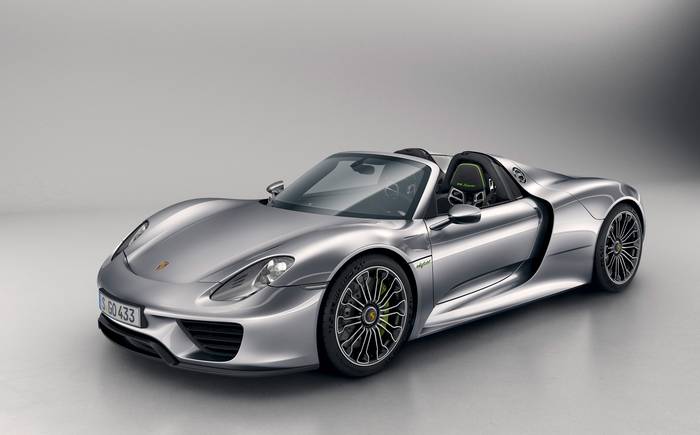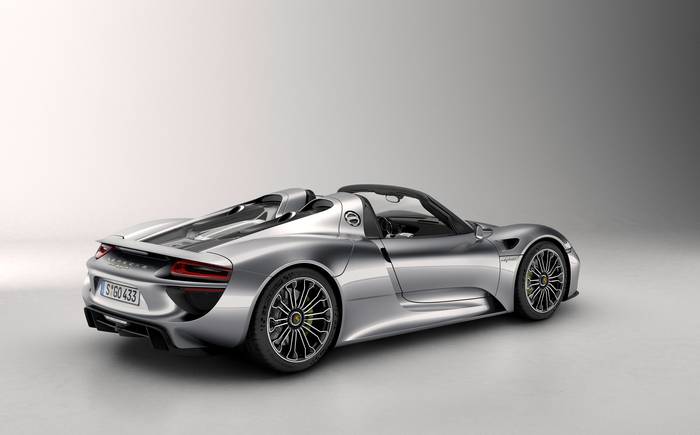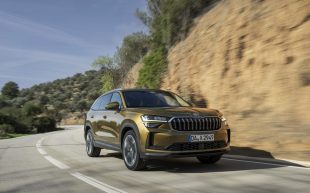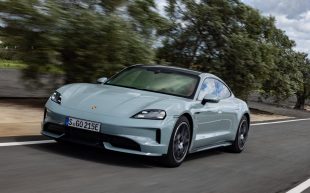First drive review: Porsche 918 Spyder (Weissach package)
My £710,000 crash course in the future

WHAT AN honour it was last week to be invited to a racetrack in Spain to be one of a select group of journalists granted the chance to try out the long-awaited new Porsche 918 Spyder.
To know the privilege of sitting behind the wheel of one of only six pre-production models made available to the world’s press of this staggering high-performance model.
To be trusted with holding in my own hands £710,000-worth of quiveringly newborn, limited-edition super-sports car that, with its fusion of breakthrough eco-engineering and record-shattering aplomb, is potentially the very future of motor racing.
Reader, I crashed it.
But before we get to that part of the story, a few figures. A plug-in hybrid whose development was announced by Porsche three years ago, the 918 has a 4.6-litre eight-cylinder petrol engine and two electric motors — one on the front axle and one in the drivetrain, acting on the rear wheels — generating a stonking total output of 874bhp.
In its standard form, this car shoots from 0 to 62mph in 6.2 seconds — and if you’re not impressed, then consider that that is just in all-electric mode. When the combustion engine joins in, the 918 gets up to that speed in a firework-like 2.8 seconds. It has an unlimited top speed of 213mph, and even on its batteries alone the car can hit 93mph.
This is, it goes without saying, the most powerful production Porsche yet built. Yet, according to the official figures, it fouls the air with CO2 at the relatively trifling rate of 79g/km, making it significantly less of a pollutant than a 0.9-litre TwinAir Fiat 500, and sips at its petrol tank with what could almost be characterised as snooty distaste.
Returning 85mpg, the 918 is on paper at least far more frugal than a 1-litre Smart Fortwo coupé. Of course, that figure is slightly contrived. If you pootle around on the batteries and keep recharging it will do 0mpg but with real-world driving — by Porsche standards — you can expect frequent fill-ups. The reward is that it will go like a bat on fire. The people at Toyota could have had no idea when they designed the Prius and hauled the flag aloft for electrically assisted, eco-sensitive motoring that one day Porsche drivers would come screaming past them with their trousers smouldering in the kidney-clenching driver’s seat of one of these.
It looks sensational — low-slung, muscular, uncompromisingly wide, butchly carrying its exhaust pipes halfway up its carbon fibre back. But how does the future of motor racing drive? Time to find out.
I am shown into a model fitted with the optional Weissach package, which essentially slims weight out of the car to squeeze from its frame even further feats of stomach-liquidising quickness, shaving 0.1 seconds off the all-electric 0-62mph and 0.2 seconds off the engine-assisted 0-62mph, while adding 1mph and an extra 10mpg, not to mention reducing its CO2 to below the 75g/km threshold for the London congestion charge. Clearly that will be a clincher for those with a few hundred thousand to spare who are agonising over whether to buy one.
The feel inside the low cockpit is itself a hybrid of hardcore, pedal-to-the-metal, teeth-to-the-steering-wheel racing car and Porsche Cayenne-style, weekend-in-Alderley Edge luxury. On the one hand, the seats are bum-bitingly thin, there’s carbon fibre all over the place and the interior ends immediately and without ceremony behind the headrest.
On the other, the lustrous leatherwork and piping appear to have been hand-worked by elves, the screen on the centre console is in curved glass — for no apparent reason other than that it looks pretty — and a state-of-the-art, gloss-black touchscreen control panel leaks from the middle of the dashboard like a giant molten iPad.
Meanwhile, a red button winks out at you from the preciously tiny driving-mode selector on the steering wheel, offering, in addition to the progressively fearless E-Power, Hybrid, Sport Hybrid and Race Hybrid modes, a Hot Lap setting. Apparently if you touch that button, a bolt of lightning drops into your lap and — never mind the future of racing — you end up back in the Fifties, inventing rock’n’roll with Michael J Fox. I’m looking forward to it, just as soon as the track is clear.
In the meantime, to pass a bit of dead time in the pit lane, I use the touchscreen to carry out a royal, all-the-way-to-11 testing of the Burmester sound system, tuning to Rock FM, which is playing Bob Dylan’s Like a Rolling Stone. It’s as though Bob himself has just burst out of the glove compartment. If there were a glove compartment, which, this being a racing car, there isn’t.
I float out onto the track in an eerie electric swoosh, and then switch into Sport Hybrid mode — at which point the engine practically jumps up at the back window and shouts, “Boo!” Or, rather, “Boom!” One warm-up lap under my belt, and the car already feeling impressively steady and confidence-inducing under my clearly expert hands, I hammer down the home straight at a pace that in a less experienced man of speed would cause both eyes to fuse in one unsightly blob above the bridge of the nose. And then I rather giftedly brake for the viciously sharp left-hander, getting it exactly right.
No, hang on: getting it exactly wrong. There’s a rumble, which is the sound of at least two, possibly three wheels drifting out to the kerb. There’s a squeal, which is the sound of the tyres fighting for traction, spinning through 360 degrees and then going backwards. Then there’s another squeal, which is me offering a yelped prayer as my mind empties of all thought and reverts to the image of the BBC test card, with the smiling girl, the clown and the blackboard.

Then there’s the sound of £710,000-worth of new Porsche sliding backwards through several tons of gravel, which is . . . £710,000-worth of new Porsche sliding backwards through several tons of gravel.
And then finally there is peace. The future of racing is now at 90 degrees to the track, eight yards or so back from the edge, buried up to its hubcaps in stones. Cue tow truck, cue slow ride home in a track car, cue the long walk of shame up the pit lane.
As Dylan plangently wonders in that timeless song, “How does it feel to be on your own?” Bob, tell me about it. In the garage I meekly linger behind the intimidating throng of Porsche personnel peering funereally into the luggage space under the bonnet that has now essentially become a roadside grit container. “Is the car OK?” I ask gingerly. Barely moving his lips, the man from Porsche says, “Well, it was all right before you drove it.”
In the end the car was OK. All it needed was four new tyres, a vacuuming, a total strip-down and a complete rebuild. And a number of new body panels. Hey, presto, good as new. Big it up to those Porsche people, too: they let me borrow another one just as soon as their resentment had lifted. Whereupon I discovered that if you give it a chance and don’t fool yourself, the 918 is not only taut and blisteringly quick but peerlessly self-assisting through even those trickily tight corners — virtually (though not quite) idiot-proof, in fact.
Later, to test Porsche’s claim that the 918 is a plausible “everyday” car that just happens to be capable of murdering the Nürburgring in a record-breaking time of 6 minutes and 57 seconds, I nipped along the motorway to Valencia for some sightseeing.
Hurtling up the outside lane with the roof unclipped, in city-sensitive electric mode, I was essentially in the milk float of Ernie’s wildest dreams, accompanied by nothing more than the wind’s hubbub and the whistle you might hear from a distant taxiing jet engine. It’s hard to reckon on silence playing a part in the future of sports car fun, but then what does the future demand if not a radical readjustment of mindset? Meanwhile, the Hybrid setting is stirringly rowdy and, again, speedy to a ridiculous degree.
Obviously in this particular everyday car you can’t really see anything: the wing mirrors provide a handsome panorama of the car’s fleshy haunches while the rear-view mirror offers a mere slither of sky between the headrests and the deployed spoiler. On the plus side, though, you won’t be stuck behind anyone for long, or have very much on your tail either.
Porsche has declared that it will build 918 of these cars. It is expecting 100 of those to stay at home in Germany and 300 to end up in America. For comparison purposes, McLaren is planning to build only 375 of its new ultra high-performance P1s (£866,000 to you), and Ferrari proposes making just 499 LaFerraris (roughly £1m). Are there 918 people in the world rich enough and speed-mad enough to buy into this bright hybrid-hypercar future at its earliest dawn? “We will be short of cars,” declared the man from Porsche. He may be right. Especially at the rate I’m going through them.
Verdict ★★★★★
A Le Mans car for the road
Factfile
- Engine:
- 4593cc, V8 petrol, plus two electric motors
- Power:
- 874bhp @8500rpm (V8: 599bhp @ 8700rpm; electric: 282bhp @ 6500rpm)
- Torque:
- 944lb ft
- Transmission:
- 7-speed PDK
- Acceleration:
- 0-62mph in 2.6sec
- Top speed:
- 214mph (93mph in electric operating mode)
- Fuel:
- 95mpg
- CO2:
- 70g/km
- Road tax band:
- A
- Dimensions:
- L 4646mm, W 1940mm, H 1167mm
The Rivals
- McLaren P1, £866,000
For Just 375 cars; 217mph top speed; designed and built in Britain Against Left-hand-drive only; sold out
- Ferrari La Ferrari, £1m
For It’s a V12 Ferrari; its predecessor the Enzo has soared in value Against Stratospheric price; Driving hasn’t tested it yet




